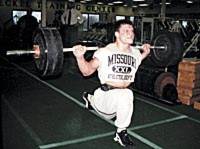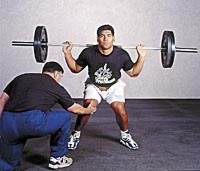COACHING MADE EASYThere are Six BFS Absolutes that are amazingly effective in teaching perfect technique not only in the weight room but in any sport. Learn these six BFS Absolutes and you can elevate your strength coBy Greg Shepard Published: Winter 1999 Every athlete and coach would find it a blessing in their weightroom and on the field if they implemented the Six BFS Absolutes in exactly the same way. When using different terminology, it breeds confusion. For example, don't say “make your chest big”, say “spread the chest.” Be consistent. On the field be sure to do the same. In other words don’t have one coach say “split end” and another one say “wide receiver.” How can an athlete be expected to follow instructions exactly when the instructions they receive seem different. It is imperative that all coaches and athletes be on the same page. Take these six points, write them down, post them on your weightroom, memorize them, and see the difference the Six BFS Absolutes will make. #1 Athletic or Jump Stance: We have two stances. We use an athletic stance in lifts like the Squat or the rack position in the Power Clean. We use the jump stance primarily when we lift from the floor: Power Clean, Snatch, Hex bar, Dead Lift, etc. Everyone else says “about shoulder width apart” or “narrower than hip width.” We want everything we do relevant to athletics. At clinics I will ask the athletes to pretend I'm their little brother. I say I am a shortstop or linebacker. I get into various stances: narrow, wide, toes out and just right. From that perspective, every athlete and coach can immediately determine a good stance from a goofy stance. This is your athletic stance. All sports use basically the same stance. It doesn't matter if it's tennis, softball or a “ready” position in football, the stance is the same. It is imperative that we always squat from an athletic stance so we can groove the strength and power we build from that stance. We want these gains meaningful and functional. Next, I ask the athletes and coaches to look at my feet as I step up to a line to do a Standing Long Jump. Again, I get into various stances. It is quite easy to see a “jump stance” from the others. Bottom Line: You either look like an athlete that's ready to hit or jump. You are in an athletic position or a jump position. Athletic stance or jump stance. #2 Be Tall: You need to be tall all the time: Walking, sprinting, squatting, lunging, cleaning. You need to practice being tall all the time even during stretching. You can't slump or lean forward outside your center of gravity. Being tall keeps you in a proper “Power Line.” Being tall will help you keep your back in a correct position. #3 Spread the Chest (Lock-in Lower Back): When athletes spread their chests, the lower back will start to lock-in properly in a concave position. As you feel this happening, just concentrate on locking-in. Spreading the chest will keep athletes upright and in the power groove. Spread the chest all the time in all activities. Use “spread the chest” on the field and in the weight room a thousand times a day. #4 Toes Aligned: Make sure the toes always look like an athlete. Sometimes for balance, athletes point their toes way out on a squat for example. Fight this tendency. Remember, we want to groove the strength we build so we can use it in the athletic arena. What is the objective? To win the athletic contest, not a weightlifting meet. BFS always asks the question, “is what we are doing going to help us win?” #5 Knees Aligned: Knees must be over toes at all times in the weight room, in every phase of strength and conditioning, in every drill and in every athletic movement. The most common problem is that athletes let their knees come together, putting pressure on the medial collateral ligament. This is especially true with women athletes and junior high boys. I yell “knees” and this means to force the knees out over the toes. If they still don't get it, then I slap the inside of their knees to get it right. At clinics, I will take athletes and get them into a “ready” position and grade their knees on a scale of one to ten. There are always bad knees and I rarely give a ten grade until this has been coached. Sometimes, the knees will be outside the toes. This is almost always due to a narrow stance. Simply widen the stance to cure this problem. Many times the knees will also be way forward in front of the toes. The athlete needs to learn to balance himself on the entire foot. The heels cannot come up. Be tall, spread the chest, eyes on target and sit with the hips well back. This will keep the knees aligned over the toes. #6 Eyes on Target: This is such a wonderful phrase with many applications. Use it all the time in the weight room and during a regular practice. Your target can change depending on the lift or the situation. Training your athletes to keep their eyes on whatever target you dictate will pay big dividends. Squat: eyes on target straight ahead. Power Clean: during the jump phase, the eyes should be on target high on the wall or on a specific point on the ceiling. In one of our feature articles in this journal, an athlete has his eyes down, thus his chin is down and thus out of his power line on a cleaning movement. Can you find it? If you do, you should start smiling as you come to realize that these Six BFS Absolutes are not only for high school beginners but advanced athletes as well. It also means you can become a strength and conditioning expert very quickly. Sprint Stance: Eyes on target three feet in front. Sprinting: Eyes on target straight ahead. Tackling: straight ahead. Jumping: straight ahead. What about when you are three points behind in a football game with only two minutes left and your opponents have the ball. What is your target? The ball! Have fun with this. Be creative! ______________________ THE BFS SIX ABSOLUTES Athletic or Jump Stance Be Tall Spread the Chest (Lock-in Lower Back) Toes Aligned Knees Aligned Eyes on Target |
 |
|
ANALYZE THIS: Former Missouri Tiger Brock Olivo demonstrates five of the Six BFS Absolutes in this Lunge with perfect form. Can you identify them. |
 |
|
Getting the knees right. |